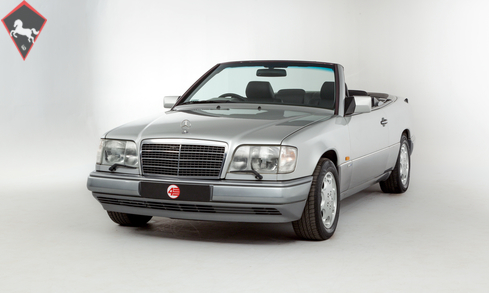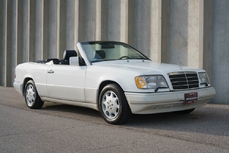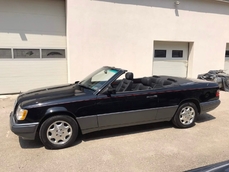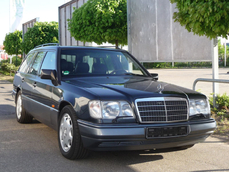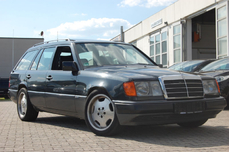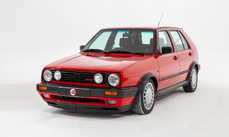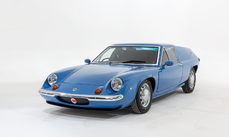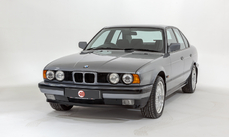Mercedes-Benz 320 w124 Sportline Cabriolet 1994
General description :
Model History
W124 was the internal chassis designation for the 1985-1995 generation of the Mercedes-Benz E-Class; it was also the first generation officially referred to as “E-Class”. W124 models replaced the W123 after 1985 and were succeeded by the W210 E-Class after 1995. The R129 SL roadster was based on the W124 platform, and in return the W124 was later equipped with the SL’s 5-litre V8 engines, creating the 500E.
Much of the 124's engineering and many of its features were advanced automotive technology at its introduction, incorporating innovations that have been adopted throughout the industry. It had one of the lowest drag coefficients of any vehicle at the time due to its aerodynamic body that included plastic moulding for the undercarriage to streamline airflow beneath the car, thus reducing fuel consumption and wind noise. It had a single windscreen wiper with an eccentric mechanism at its base that extended the wiper's reach to the top corners of the windscreen, more than if it had travelled in a simple arc. The saloons, coupés, and convertibles had optional rear headrests that would fold down remotely to improve rearward visibility when required.
Mercedes launched the convertible version of the W124, the 300CE-24 cabriolet, in 1991. It was re-designated as the E320 in 1993. The “Sportline” option came as standard with sports seating (although not when leather was specified), wider wheels (7-inch rather than 6.5-inch) with wider profile tyres (205/60 15 rather than 195/65 15), quick ratio steering and a smaller diameter steering wheel, "Sportline" designation on the gearknob, slightly lowered ride height, and a specially tuned suspension including shorter, stiffer springs, struts, anti-roll bars, and bushings.
Equipment
Brilliant Silver Metallic paintwork (744), Black leather upholstery (261), Electric folding soft-top in black, Sports chassis with 8-hole alloy wheels and wide tyres (653), 390mm Sports steering wheel and Sportline leather gearshift (281), Cruise control, Electrically adjustable front seats with driver and passenger memory, Electric windows, Air conditioning, Electrically adjustable door mirrors, Electrically adjustable steering column, Self-dimming rear view mirror, Outside temperature indicator, Driver and passenger front airbags, Electric aerial, Folding front armrest, Rear armrest, Headlamp wash/wipe, Remote central locking, Fire extinguisher, Original Mercedes cassette radio, Active bass loudspeaker system, Alpine CD changer, Privacy glass, Spare wheel, Mercedes tool roll.
Exterior
This handsome 124 cabriolet looks magnificent in two-tone metallic silver, a timeless choice for a Mercedes of this vintage. As a factory Sportline the car boasts specially tuned suspension including shorter and stiffer springs, struts, anti-roll bars and bushings for better handling, lower ride height and a more impressive stance. Wider eight-hole wheels and tyres complete the look.
The car presents in really nice condition throughout. There are just a handful of discreet blemishes to report on close inspection, the worst being some minor blemishes along the rear bumper. At the front of the car you’ll find crystal clear headlamps with the handy washer system, and along the sides all panels are looking nice and straight. The Mercedes also sports privacy glass and an electric folding hood, the condition of which is first-rate.
Interior
The interior is really what sets this example apart from the others. The supple upholstery retains an excellent matte sheen, free from the shininess and wear of higher mileage examples. Black leather extends to the door cards, the smaller diameter sports steering wheel, and Sportline gear knob. Both front seats are fully electric with memory for maximum comfort at the touch of a button, and the new-looking rear seats have electrically retractable head restraints that act as a roll bar when the roof is down. Glancing across the dash and along the centre console you’ll find unmarked walnut veneer with the original Mercedes cassette radio in place. The anthracite carpets are also pristine having always been protected in the footwells by tailored Mercedes overmats. The factory-optional fire extinguisher is still fitted below the front passenger seat.
ENGINE & TRANSMISSION
The engine bay is remarkably well preserved, presenting to an excellent standard with no signs of any damage or poor repair upon inspection. There’s no corrosion to be found to any of the painted areas and all ancillaries appear in fine fettle. The car has been freshly serviced at the current mileage and runs beautifully. With a mere 36k miles to its name the engine pulls well and the auto ‘box shifts seamlessly through the gears. The MOT is valid until May 2020.
WHEELS, TYRES & BRAKES
One of the Sportline’s main features is the sports chassis with wider wheels and tyres (option code 653). This means that the classic eight-hole design alloys are actually 7 inches wide instead of the usual 6.5 inches. With the wider tyres and specially tuned suspension the Sportline handles remarkably well and has a much more commanding presence on the road.
All four alloys have just returned from Lepsons having been fully refurbished to the highest standard. Brand new OEM centre caps have also been fitted to complete the ‘as new’ finish. The wheels are shod in a matching set of Continental tyres all round, each with ample tread remaining. The brakes perform well on test.
History File
This rare Sportline cabriolet was first registered in April 1994; it was supplied new by Alan Day Mercedes in London. The History File is complete with the original Mercedes wallet and manuals, including the maintenance booklet with 11 service entries at the following mileages: 983, 4k, 9k, 12k, 18k, 24k, 27k, 29k, 31k, 33k, and most recently at 36k. We have just had the car fully inspected, serviced, and MOT’d at the current mileage for the new keeper’s piece of mind.
http://www.4starclassics.com/for-sale/mercedes-e320-sportline-cabriolet-for-sale/
1994 Mercedes-Benz 320 w124 Sportline Cabriolet is listed sold on ClassicDigest in Kingsley by 4 Star Classics for £19995.
Car Facts
Car type : Car Make : Mercedes-Benz Model : 320 w124 Model Version : Sportline Cabriolet Engine size : 3.2 Model Year : 1994 Sub type : Convertible Location : Hampshire
Sold
Seller Information
Sold
People who viewed this Mercedes-Benz 320 w124 also viewed similar Mercedes-Benz listed at ClassicDigest
Other cars listed for sale by this dealer
About Mercedes-Benz
In the annals of automotive history, the journey of Mercedes-Benz is a tale that unfolds with the ingenuity of its founding pioneers. In the year 1886, Karl Benz crafted the Benz Patent Motorwagen, a creation that would go down in history as the world's inaugural automobile. Unbeknownst to him, this moment marked the genesis of what would evolve into the most illustrious premium car manufacturer globally. The financial underpinning of this pioneering venture, interestingly, was provided by Karl Benz's wife, Bertha Benz, demonstrating a remarkable partnership that would set the tone for Mercedes-Benz's legacy.A parallel narrative emerged not far away, as Daimler-Motoren-Gesellschaft, founded by Gottlieb Daimler and Wilhelm Maybach, entered the scene. In 1901, they unveiled their automobile under the now-famous moniker "Mercedes," meaning "godsend" in Spanish. This name was bestowed upon the car at the behest of Emil Jellinek's daughter, the distributor for Daimler-Motoren-Gesellschaft. The wheels of innovation were set in motion.
Fast forward to 1926, a pivotal year that witnessed the merger of Daimler with Benz & Cie., culminating in the birth of Daimler-Benz. The amalgamation saw the adoption of "Mercedes-Benz" as the distinguished trademark for their automobiles, fusing the legacies of two visionary entities into one.
Contrary to perceptions of conservatism, the trajectory of Daimler-Benz unfolds as a chronicle of industry firsts. From the introduction of the honeycomb radiator to the float carburetor, and the pioneering implementation of four-wheel brakes in 1924, Daimler-Benz consistently pushed the boundaries of automotive innovation. The diesel-powered Mercedes-Benz 260 D in 1936 marked the inception of diesel engines in passenger cars. The iconic Mercedes-Benz 300SL Gullwing made history as the first car with direct fuel injection, albeit the Gutbrod's tiny 2-stroke engine can claim precedence.
Safety innovations became a hallmark, with Béla Barényi's patented safety cell design in the "Ponton"-models in 1951, featuring front and rear crumple zones. The W116 450SEL 6.9 saw the introduction of the Anti-Lock Brake system (ABS), another pioneering safety feature. From the first production airbags and beyond, the legacy of "firsts" continued to be etched into the fabric of Daimler-Benz.
Over its centennial journey, Mercedes-Benz has not merely produced cars but has sculpted automotive icons. The SSKL, 710 SSK Trossi Roadster, 770K Grosser, 540K Spezial Roadster, 300SL Gullwing, w100 600 Pullman, w111 280SE 3.5 Flachkühler, w113 230SL Pagoda, w109 300 SEL 6.3, and w201 2.3-16 Cosworth stand testament to the brand's commitment to engineering excellence.
The roaring Silver Arrows, or "Silberpfeile," including the W 25, W 125, W154, W165, and W196, created a legacy of dominance on the racetrack. These machines were not merely cars; they were expressions of precision, speed, and an indomitable spirit that left their competitors in the dust.
As Mercedes-Benz marches into the future, it does so not just as an automaker but as a custodian of a legacy, a torchbearer of innovation, and a beacon of automotive excellence. The road ahead is sure to witness the continued fusion of cutting-edge technology, timeless design, and an unwavering commitment to setting new standards in the world of automobiles.
One luminary figure who left an indelible mark was Béla Barényi, often heralded as the "father of passive safety" for his pioneering work in safety engineering. His patented safety cell design, featuring front and rear crumple zones, became a hallmark of Mercedes-Benz's commitment to occupant safety, setting new standards that reverberated throughout the automotive world.
Moving through the chronicles, the collaborative genius of Wilhelm Maybach, alongside Gottlieb Daimler, laid the foundation for Daimler-Motoren-Gesellschaft. Their innovations not only birthed the first Mercedes but established a culture of relentless pursuit of technological excellence that remains integral to Mercedes-Benz's DNA.
In the post-merger era of 1926, Ferdinand Porsche emerged as a prominent figure within Mercedes-Benz. His work on the Mercedes-Benz S-Type, a supercharged race car, garnered acclaim and set the stage for a legacy that extended far beyond the marque. Porsche's impact would later extend to his eponymous company, but his influence at Mercedes-Benz during those formative years was pivotal.
As the 20th century progressed, the legendary Rudolf Uhlenhaut emerged as a key figure. Uhlenhaut, an accomplished engineer and the driving force behind the iconic Silver Arrows, played a crucial role in Mercedes-Benz's dominance in motorsports. His engineering prowess and attention to detail were instrumental in creating some of the most formidable racing cars of the era.
In the latter half of the century, figures like Bruno Sacco, the head of design at Mercedes-Benz from 1975 to 1999, left an indelible imprint on the brand's aesthetic identity. Sacco's design philosophy, characterized by clean lines and timeless elegance, shaped iconic models like the W126 S-Class and the W201 190E, solidifying Mercedes-Benz's reputation for luxury and sophistication.
The narrative would be incomplete without acknowledging the contributions of engineers like Hans Scherenberg, whose leadership in the 1970s ushered in a new era of technological innovation at Mercedes-Benz. Scherenberg's tenure saw the development of groundbreaking technologies, including the Anti-Lock Brake system (ABS) and the introduction of airbags in production cars.
